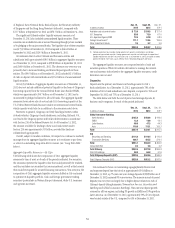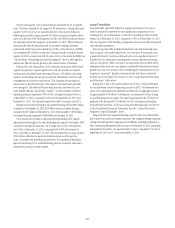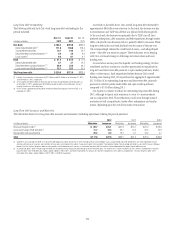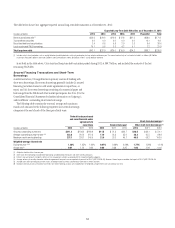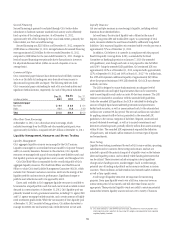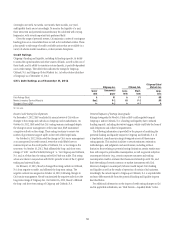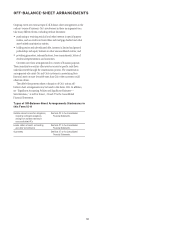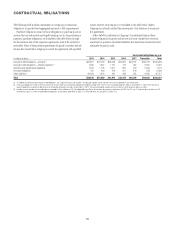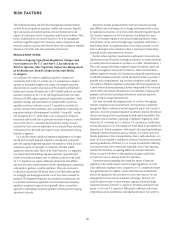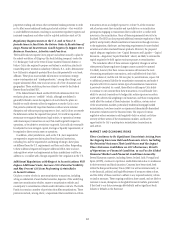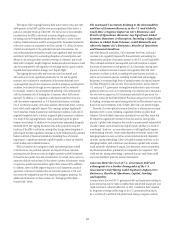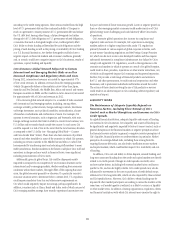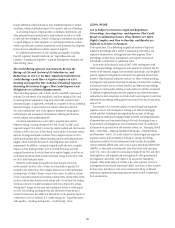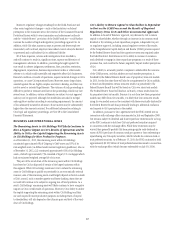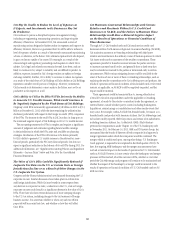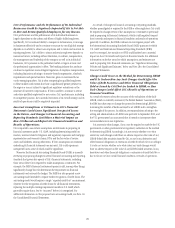Citibank 2012 Annual Report Download - page 83
Download and view the complete annual report
Please find page 83 of the 2012 Citibank annual report below. You can navigate through the pages in the report by either clicking on the pages listed below, or by using the keyword search tool below to find specific information within the annual report.61
compete with its U.S. and non-U.S. competitors and further negatively impact
Citi’s results of operations. For example, Citi conducts a substantial portion of
its derivatives activities through Citibank, N.A. Pursuant to the CFTC’s current
and proposed rules on cross-border implications of the new derivatives
registration and trading requirements under the Dodd-Frank Act, clients
who transact their derivatives business with overseas branches of Citibank,
N.A. could be subject to U.S. registration and other derivatives requirements.
Clients of Citi and other large U.S. financial institutions have expressed an
unwillingness to continue to deal with overseas branches of U.S. banks if the
rules would subject them to these requirements. As a result, Citi could lose
clients to non-U.S. financial institutions that are not subject to the same
compliance regime.
Continued Uncertainty Regarding the Timing and
Implementation of Future Regulatory Capital
Requirements Makes It Difficult to Determine the Ultimate
Impact of These Requirements on Citi’s Businesses
and Results of Operations and Impedes Long-Term
Capital Planning.
During 2012, U.S. regulators proposed the U.S. Basel III rules that would be
applicable to Citigroup and its depository institution subsidiaries, including
Citibank, N.A. U.S. regulators also adopted final rules relating to Basel II.5
market risk that were effective on January 1, 2013. This new regulatory
capital regime will increase the level of capital required to be held by Citi,
not only with respect to the quantity and quality of capital (such as capital
required to be held in the form of common equity), but also as a result of
increasing Citi’s overall risk-weighted assets.
There continues to be significant uncertainty regarding the overall timing
and implementation of the final U.S. regulatory capital rules. For example,
while the U.S. Basel III rules have been proposed, additional rulemaking and
interpretation is necessary to adopt and implement the final rules. Overall
implementation phase-in will also need to be finalized by U.S. regulators,
and it remains to be seen how U.S. regulators will address the interaction
between the new capital adequacy rules, Basel I, Basel II, Basel II.5 and
the proposed “standardized” approach serving as a “floor” to the capital
requirements of “advanced approaches” institutions, such as Citigroup.
(For additional information on the current and proposed regulatory capital
standards applicable to Citi, see “Capital Resources and Liquidity – Capital
Resources – Regulatory Capital Standards” above.) As a result, the ultimate
impact of this new regime on Citi’s businesses and results of operations
cannot currently be estimated.
Based on the proposed regulatory capital regime, the level of capital
required to be held by Citi will likely be higher than most of its U.S. and
non-U.S. competitors, including as a result of the level of DTAs recorded
on Citi’s balance sheet and its strategic focus on emerging markets (which
could result in Citi having higher risk-weighted assets under Basel III than
those of its global competitors that either lack presence in, or are less focused
on, such markets). In addition, while the Federal Reserve Board has yet
to finalize any capital surcharge framework for U.S. “global systemically
important banks” (G-SIBs), Citi is currently expected to be subject to a
surcharge of 2.5%, which will likely be higher than the surcharge applicable
to most of Citi’s U.S. and non-U.S. competitors. Competitive impacts of the
proposed regulatory capital regime could further negatively impact Citi’s
businesses and results of operations.
Citi’s estimated Basel III capital ratios necessarily reflect management’s
understanding, expectations and interpretation of the proposed U.S. Basel
III requirements as well as existing implementation guidance. Furthermore,
Citi must incorporate certain enhancements and refinements to its Basel
II.5 market risk models, as required by both the Federal Reserve Board and
the OCC, in order to retain the risk-weighted asset benefits associated with
the conditional approvals received for such models. Citi must also separately
obtain final approval from these agencies for the use of certain credit risk
models that would also yield reduced risk-weighted assets, in part, under
Basel III.
All of these uncertainties make long-term capital planning by Citi’s
management challenging. If management’s estimates and assumptions
with respect to these or other aspects of U.S. Basel III implementation are
not accurate, or if Citi fails to incorporate the required enhancement and
refinements to its models as required by the Federal Reserve Board and the
OCC, then Citi’s ability to meet its future regulatory capital requirements as
it projects or as required could be negatively impacted, or the business and
financial consequences of doing so could be more adverse than expected.
The Ongoing Implementation of Derivatives Regulation
Under the Dodd-Frank Act Could Adversely Affect Citi’s
Derivatives Businesses, Increase Its Compliance Costs and
Negatively Impact Its Results of Operations.
Derivatives regulations under the Dodd-Frank Act have impacted and will
continue to substantially impact the derivatives markets by, among other
things: (i) requiring extensive regulatory and public reporting of derivatives
transactions; (ii) requiring a wide range of over-the-counter derivatives to
be cleared through recognized clearing facilities and traded on exchanges
or exchange-like facilities; (iii) requiring the collection and segregation of
collateral for most uncleared derivatives; and (iv) significantly broadening
limits on the size of positions that may be maintained in specified derivatives.
These market structure reforms will make trading in many derivatives
products more costly, may significantly reduce the liquidity of certain
derivatives markets and could diminish customer demand for covered
derivatives. These changes could negatively impact Citi’s results of operations
in its derivatives businesses.
Numerous aspects of the new derivatives regime require costly and
extensive compliance systems to be put in place and maintained. For
example, under the new derivatives regime, certain of Citi’s subsidiaries have
registered as “swap dealers,” thus subjecting them to extensive ongoing
compliance requirements, such as electronic recordkeeping (including
recording telephone communications), real-time public transaction
reporting and external business conduct requirements (e.g., required swap
counterparty disclosures), among others. These requirements require the
successful and timely installation of extensive technological and operational
systems and compliance infrastructure, and Citi’s failure to effectively install


